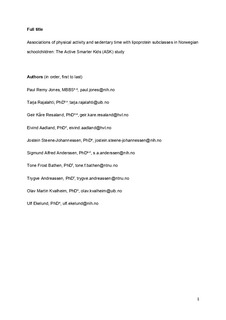| dc.contributor.author | Jones, Paul Remy | |
| dc.contributor.author | Rajalahti, Tarja | |
| dc.contributor.author | Resaland, Geir Kåre | |
| dc.contributor.author | Aadland, Eivind | |
| dc.contributor.author | Steene-Johannessen, Jostein | |
| dc.contributor.author | Anderssen, Sigmund Alfred | |
| dc.contributor.author | Bathen, Tone Frost | |
| dc.contributor.author | Andreassen, Trygve | |
| dc.contributor.author | Kvalheim, Olav Martin | |
| dc.contributor.author | Ekelund, Ulf | |
| dc.date.accessioned | 2020-03-05T08:08:20Z | |
| dc.date.available | 2020-03-05T08:08:20Z | |
| dc.date.created | 2019-08-06T11:39:51Z | |
| dc.date.issued | 2019 | |
| dc.identifier.citation | Atherosclerosis. 2019, 288 186-193. | nb_NO |
| dc.identifier.issn | 0021-9150 | |
| dc.identifier.uri | http://hdl.handle.net/11250/2645375 | |
| dc.description.abstract | Background and aims: Physical activity is favourably associated with certain markers of lipid metabolism. The relationship of physical activity with lipoprotein particle profiles in children is not known. Here we examine cross-sectional associations between objectively measured physical activity and sedentary time with serum markers of lipoprotein metabolism. Methods: Our cohort included 880 children (49.0% girls, mean age 10.2 years). Physical activity intensity and time spent sedentary were measured objectively using accelerometers. 30 measures of lipoprotein metabolism were quantified using nuclear magnetic resonance spectroscopy. Multiple linear regression models adjusted for age, sex, sexual maturity and socioeconomic status were used to determine associations of physical activity and sedentary time with lipoprotein measures. Additional models were adjusted for adiposity. Isotemporal substitution models quantified theoretical associations of replacing 30 min of sedentary time with 30 min of moderate- to vigorous-intensity physical activity (MVPA). Results: Time spent in MVPA was associated with a favourable lipoprotein profile independent of sedentary time. There were inverse associations with a number of lipoprotein measures, including most apolipoprotein B-containing lipoprotein subclasses and triglyceride measures, the ratio of total to high-density lipoprotein (HDL) cholesterol, and non-HDL cholesterol concentration. There were positive associations with larger HDL subclasses, HDL cholesterol concentration and particle size. Reallocating 30 min of sedentary time to MVPA had broadly similar associations. Sedentary time was only partly and weakly associated with an unfavourable lipoprotein profile. Conclusions: Physical activity of at least moderate-intensity is associated with a favourable lipoprotein profile in schoolchildren, independent of time spent sedentary, adiposity and other confounders. | nb_NO |
| dc.language.iso | eng | nb_NO |
| dc.publisher | Elsevier | nb_NO |
| dc.rights | Attribution-NonCommercial-NoDerivatives 4.0 Internasjonal | * |
| dc.rights.uri | http://creativecommons.org/licenses/by-nc-nd/4.0/deed.no | * |
| dc.title | Associations of physical activity and sedentary time with lipoprotein subclasses in Norwegian schoolchildren: The Active Smarter Kids (ASK) study | nb_NO |
| dc.type | Journal article | nb_NO |
| dc.type | Peer reviewed | nb_NO |
| dc.description.version | acceptedVersion | nb_NO |
| dc.source.pagenumber | 186-193 | nb_NO |
| dc.source.volume | 288 | nb_NO |
| dc.source.journal | Atherosclerosis | nb_NO |
| dc.identifier.doi | 10.1016/j.atherosclerosis.2019.05.023 | |
| dc.identifier.cristin | 1714300 | |
| dc.description.localcode | © 2019. This is the authors’ accepted and refereed manuscript to the article. Locked until 5.6.2020 due to copyright restrictions. This manuscript version is made available under the CC-BY-NC-ND 4.0 license http://creativecommons.org/licenses/by-nc-nd/4.0/ | nb_NO |
| cristin.unitcode | 194,65,25,0 | |
| cristin.unitname | Institutt for sirkulasjon og bildediagnostikk | |
| cristin.ispublished | true | |
| cristin.fulltext | postprint | |
| cristin.qualitycode | 1 | |

